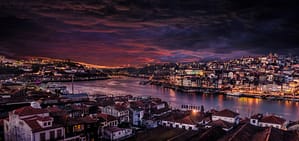Bicycle
Despite the narrow alleyways, steep hills and cobbled streets, cyclists are ubiquitous in Porto, and there are some particularly great rides along the Douro on dedicated bike paths from Ribeira to Foz or from Vila Nova de Gaia to Afurada and beyond.
Bike rental outlets include Fold ‘n’ Visit, L&L and Porto Rent a Bike. A full day’s rental will set you back around €15. Many also offer guided cycling tours.
Vieguini has a great selection of high-quality mountain bikes and also rents motor scooters (€28 per day).
Bus
Porto’s transport agency STCP runs an extensive bus system with central hubs at Praça da Liberdade (the south end of Av dos Aliados), Praça Almeida Garrett (in front of São Bento train station) and Cordoaria.
Special all-night lines also run approximately hourly, leaving Aliados on the hour and returning on the half-hour from 1am to 5.30am.
City turismos have maps and timetables for day and night routes.
Car & Motorcycle
Driving in central Porto is stressful – avoid it if possible. Narrow one-way streets, construction and heavy traffic can turn 500m into half a morning.
Street parking is tight, with a two-hour maximum stay on weekdays. There is no limit on weekends and parking spaces are more readily available.
Most squares have underground, fee-charging lots – follow the blue Ps. Be aware that opportunistic locals may guide you into places and then expect tips. They can be very disagreeable if you don’t comply. They may also direct you into an illegal spot – be sure to double-check signs.
Funicular
The restored Funicular dos Guindais shuttles up and down a steep incline with tremendous river and bluff views from Av Gustavo Eiffel, opposite Ponte de Dom Luís I, to Rua Augusto Rosa, near Batalha and the cathedral. The funicular is part of the Andante Card scheme (www.linhandante.com).
Metro
Porto’s newish metro system is compact and fairly easy to navigate – though not comprehensive. Running from around 6am to 1am daily, it comprises six metropolitan lines that all converge at the Trindade stop.
Three lines – Linha A (blue, to Matosinhos), Linha B (red, to Vila do Conde and Póvoa de Varzim) and Linha C (green, to Maia) – run from Estádio do Dragão via Campanhã train station through the city centre, and then on to far-flung northern and western suburbs.
Linha D (yellow) runs north–south from Hospital São João to João de Deus in Vila Nova de Gaia, crossing the upper deck of Ponte de Dom Luís I. Key stops include Aliados and São Bento station.
Linha E (violet) connects Linha B with the airport.
Linha F (orange) links Senhora da Hora to Fânzeres.
Taxi
There are taxi ranks throughout the centre, or you can call Táxis Invicta. Count on paying around €5 to €7 for trips within the centre during the day, with a 20% surcharge at night. There’s an extra charge if you leave the city limits, which includes Vila Nova de Gaia.
Tram
Only three Porto tram lines remain, but they’re very scenic.
The Massarelos stop, on the riverfront near the foot of the Palácio de Cristal, is the tram system’s hub. From here, line 1 trundles along the river to nearby Praça Infante Dom Henrique (Ribeira). Line 1E (appears as a crossed-out ‘1’) heads down the river in the opposite direction, towards Foz do Douro.
Line 18 heads uphill to the Igreja do Carmo and Jardim do Cordoaria.
Line 22 makes a loop through the centre from Carmo to Batalha/Guindais.
Trams run approximately every 30 minutes from 8am to 9pm.
One-way tickets cost €3; a two-day adult/child pass costs €10/5

